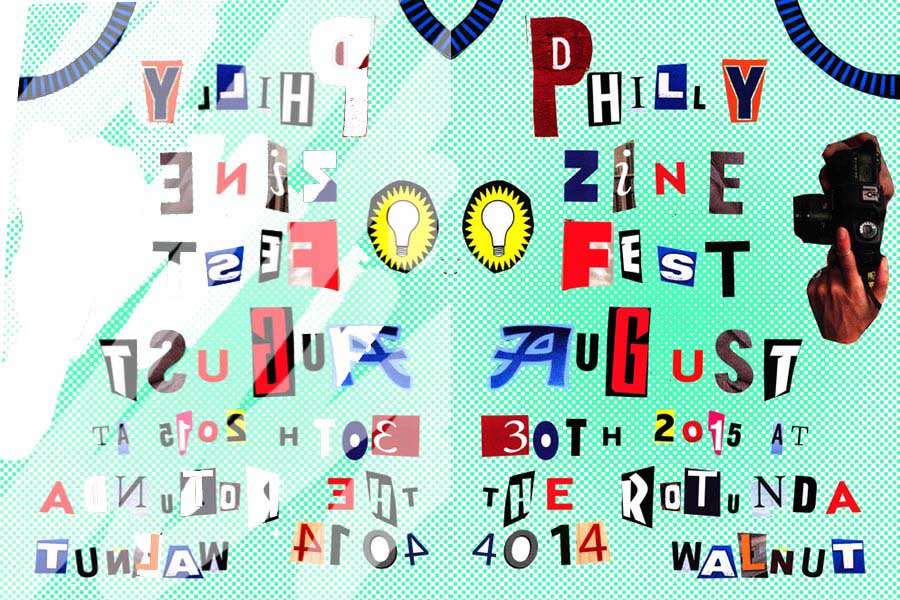“When I came to Zine Fest for the first time, in 2003, afterwards I felt like, ‘Why can’t the whole world be like Zine Fest?’” said long-time exhibitor Kate Haegele of the linguistics zine “The La-La Theory” and her memoir “White Elephants.”
“The zine community isn’t passive, they’re doers. Everyone is so supportive because they know doing this isn’t easy,” she added. “Finding zine people meant finding my people.”
Philly Zine Fest was started in 2003 by Casey Grebowski and Sarah Sawyer-Lovett. The fest is a day-long celebration — held this year noon-7 p.m. Aug. 30 at The Rotunda, 4014 Walnut St. — of indie publishing that includes more than 30 exhibitors and is attended by an estimated 300 people each year. This year, the exhibitors and organizers are looking forward to expanding the celebration of all things independent, creative and DIY.
Queer herstorian Elvis, author of the LGBT history comic “Homos in Herstory,” has been involved with PZF since 2010.
“I started writing ‘Homos in Herstory’ because I was reading all these big books about queer history and I wanted to share all these stories with everyone I knew. Queer history is the history of real people, not kings and generals,” Elvis said. “There’s something really special and unique about Philly Zine Fest. People feel comfortable here and they feel safe sharing.”
Historically, a zine (a play on the word “magazine”) has been defined as a self-published booklet about absolutely anything the writer or writers care to express. There are zines about gossip, health care, art, alien abduction, comics, personal essays, sexual assault, witchcraft and magic spells, fiction, anti-capitalist manifestos and poetry.
Zine historians have made the argument that Thomas’ Paine’s “Common Sense” counts as one of the earliest zines: It was self-published, self-distributed and contained rebellious ideas that newspapers weren’t legally allowed to publish. The earliest organized zine communities were “Star Trek” fans, who wrote and drew fanzines they’d share by mail. The most popular subject in these zines by far was the love between Kirk and Spock.
“The LGBT community and the zine communities intersect, because the need to self-represent is so deep, and there’s so much room for cool topics. You can be open and share yourself in a way that you won’t ever see in mainstream media,” Elvis said.
The zine community in the ’70s, ’80s and ’90s was instrumental in helping keep anarchists, punks and riot grrrls organized and in touch with each other across the world. Riot grrrl bands such as Bratmobile and Bikini Kill started through zines.
Rebecca Kathrine Hirsch, of the Permament Wave Philly collective, added: “In our collective zines, we find it’s so valuable to create zines with others, and to see what they have to say in contrast and in concert with your own experiences, as feminists, or as queer people or otherwise. Confidence is engendered by the license to create.”
Today, there are zine archives across the country, including the West Philadelphia zine archive and workshop The Soapbox, the Queer Zine Archive Project in Milwaukee and the Barnard Zine Library and Lesbian Herstory Archives, both in New York City. Zine fests happen across the country and, through traditional mail and the Internet, the community is a thriving, vibrant network.
“There’s always been overlap in activism and the zine community,” Elvis said. “When you’re trying to publish something to make money, it changes the subject matter. Zinesters aren’t trying to make money; that keeps them very pure and personal.”
Haegele added: “Above all, zines are about original ideas. You can pick up a zine and still be surprised, find something to laugh about and be challenged, and I find it all very life-affirming.”
This year’s exhibitors include weekly newsletter “The Philadelphia Secret Admirer,” feminist collective “Permanent Wave,” “Black Lives Matter Philly,” the sci-fi collective “Metropolarity,” the “Philadelphia Survivor Support Collective,” “Homos in Herstory,” “The Soapbox,” “The La La Theory” and “Safe Home,” created by PZF co-founder Sawyer-Lovett. Radio station WKDU will broadcast the event and there will be a zine reading the night before at Eris Arts Temple in West Philadelphia.
This year’s organizers, Ken R. and Dre G., have been attending zine festivals across the country together for several years. They’ve organized art shows and basement concerts together, but this is their first time hosting PZF.
“This is such an important event, where people can express themselves honestly and just be colorful and really free,” said Ken.
“Zine Fest is a big cause and we’re so happy to keep it alive,” Dre added. “It means a lot to so many people. We were excited we could step up. Philly is coming up and having such a big moment right now. So much creativity is blossoming.”
They’re looking forward to expanding PZF’s programming next year to include multiple events across the city, as well as fundraisers for the festival’s upkeep.
For more information, visit http://phillyzinefest.tumblr.com/.
